“How I Made It”
IAC Bulletin 2, no. 4 (January 1934), 7-9.
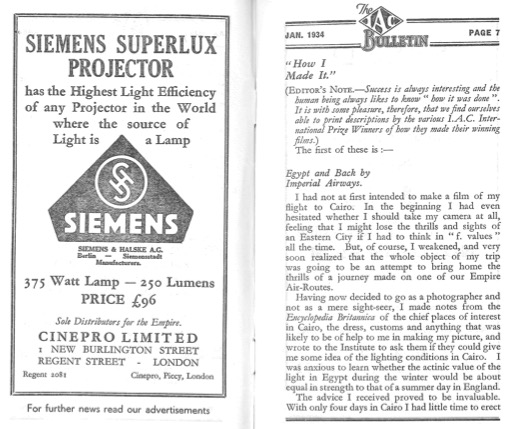
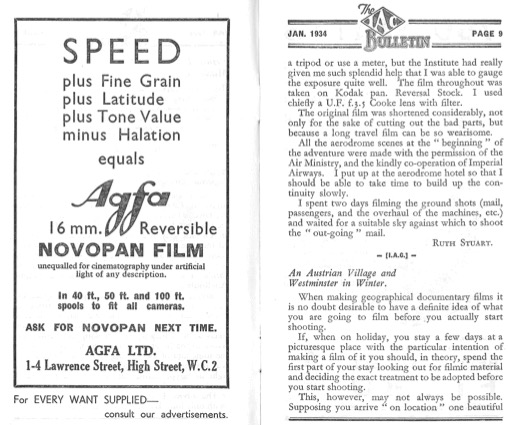
Ruth Stuart, “Egypt and Back by Imperial Airways,” 7 & 9.
I had not at first intended to make a film of my flight to Cairo. In the beginning I had even hesitated whether I should take my camera at all, feeling that I might lose the thrills and sights of an Eastern City if I had to think in “f. values” all the time. But, of course, I weakened, and very soon realized that the whole object of my trip was going to be an attempt to bring home the thrills of a journey made on one of our Empire Air-Routes.
Having now decided to go as a photographer and not as a mere sight-seer, I made notes from the Encyclopedia Britannica of the chief places of interest in Cairo, the dress, customs and anything that was likely to be of help to me in making my picture, and wrote to the Institute to ask them if they could give me some idea of the lighting conditions in Cairo. I was anxious to learn whether the actinic value of the light in Egypt during the winter would be about equal in strength to that of a summer day in England.
The advice I received proved to be invaluable. With only four days in Cairo I had little time to erect a tripod or use a meter, but the Institute had really given me such splendid help that I was able to gauge the exposure quite well. The film throughout was taken on Kodak pan. Reversal Stock. I used chiefly a U.F. f.3.5 Cooke lens with filter.
The original film was shortened considerably, not only for the sake of cutting out the bad parts, but because a long travel film can be so wearisome.
All the aerodrome scenes at the “beginning” of the adventure were made with the permission of the Air Ministry, and the kindly co-operation of Imperial Airways. I put up at the aerodrome hotel so that I should be able to take time to build up the continuity slowly.
I spent two days filming the ground shots (mail, passengers, and the overhaul of the machines, etc.) and waited for a suitable sky against which to shoot the “out-going” mail.
Matthew L. Nathan, “An Austrian Village and Westminster in Winter,” 9 & 11-12.
When making geographical documentary films it is no doubt desirable to have a definite idea of what you are going to film before you actually start shooting.
If, when on holiday, you stay a few days at a picturesque place with the particular intention of making a film of it you should, in theory, spend the first part of your stay looking out for filmic material and deciding the exact treatment to be adopted before you start shooting.
This, however, may not always be possible. Supposing you arrive “on location” one beautiful summer evening and hear the wireless announcing, “… a ridge of high pressure is slowly receding westwards, weather will probably continue mainly fair (apart from local early morning mist or fog) for a further forty-eight hours….” Would you then waste a precious day’s sunshine discovering just what it is worth your while to shoot? No, you would start early next morning as soon as the local mist (or fog) had dispersed, filming any subject that you thought looked promising.
This was, I confess, how I filmed An Austrian Village, relying on my natural flair for jig-saw puzzles to help me produce some sort of continuity when I reached the cutting stage. It is generally possible to produce sufficient continuity by this rather unacademic method, provided that a fairly large number of shots are taken in sequences or groups. Most subjects require to be covered by groups of shots – distant shots, medium distance, and close-ups – which can be arranged to give a continuity within the individual subject. Points of similarity between the different sequences can afterwards be determined, and by careful arrangement these can be used to give coherence to the film as a whole. Any shots which cannot be fitted in to the general continuity must be firmly excluded, but these will probably not be more than about 10 per cent. of the material available. The individual subjects should naturally be as varied as possible, the finished film being a balanced mixture of scenic and human interest.
In the film Westminster in Winter variety was my foremost consideration. The more variety that there is in a film the less chance is there of the audience noticing errors of construction and treatment. This may be elementary but it is vitally important, as nothing is so much to be avoided as excessive repetition. When making documentary films it is easy to be carried away by the available material. It is very difficult to refrain from turning a vast footage on subjects which stand out for their sheer beauty or novelty. If, however, an audience’s reaction to continued overstatement is kept in mind, this temptation will be resisted; production costs will thereby be reduced, and the resulting film will be of far greater interest.’
IAC Bulletin 2, no. 4 (January 1934), 12-14
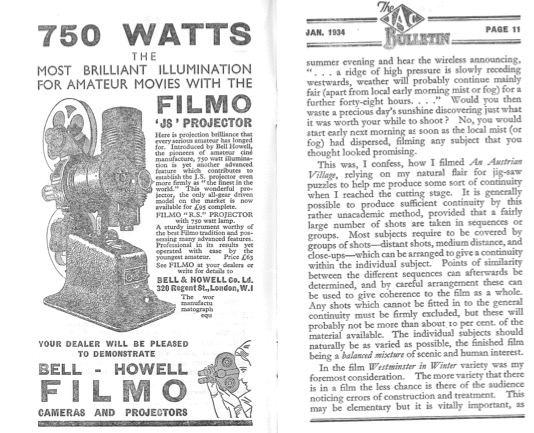
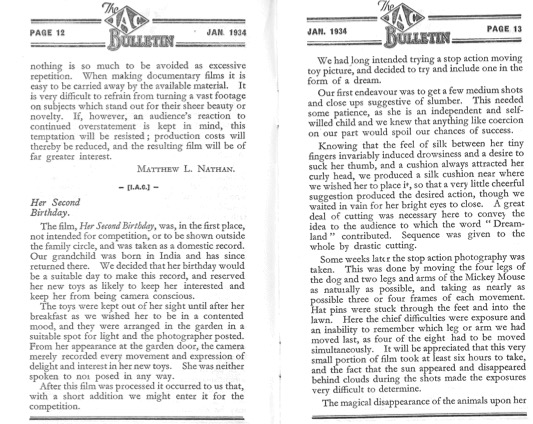
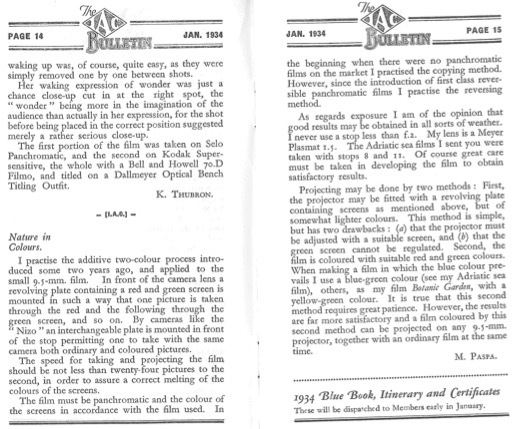
Agnes K. Thubron, “Her Second Birthday,”
The film, Her Second Birthday, was, in the first place, not intended for competition, or to be shown outside the family circle, and was taken as a domestic record. Our grandchild was born in India and has since returned there. We decided that her birthday would be a suitable day to make this record, and reserved her new toys as likely to keep her interested and keep her from being camera conscious.
The toys were kept out of her sight until after her breakfast as we wished her to be in a contented mood, and they were arranged in the garden in a suitable spot for light and the photographer posted. From her appearance at the garden door, the camera merely recorded every movement and expression of delight and interest in her new toys. She was neither spoken to nor posed in any way.
After this film was processed it occurred to us that, with a short addition we might enter it for the competition.
We had long intended trying a stop action moving toy picture, and decided to try and include one in the form of a dream.
Our first endeavour was to get a few medium shots and close ups suggestive of slumber. This needed some patience, as she is an independent and self-willed child and we knew that anything like coercion on our part would spoil our chances of success.
Knowing that the feel of silk between her tiny fingers invariably induced drowsiness and a desire to suck her thumb, and a cushion always attracted her curly head, we produced a silk cushion near where we wished her to place it, so that a very little cheerful suggestion produced the desired action, though we waited in vain for her bright eyes to close. A great deal of cutting was necessary here to convey the idea to the audience to which the word “Dreamland” contributed. Sequence was given to the whole by drastic cutting.
Some weeks later the stop action photography was taken. This was done by moving the four legs of the dog and two legs and arms of the Mickey Mouse as naturally as possible, and taking as nearly as possible three or four frames of each movement. Hat pins were stuck through the feet and into the lawn. Here the chief difficulties were exposure and an inability to remember which leg or arm we had moved last, as four of the eight had to be moved simultaneously. It will be appreciated that this very small portion of film took at least six hours to take, and the fact that the sun appeared and disappeared behind clouds during the shots made the exposures very difficult to determine.
The magical disappearance of the animals upon her waking up was, of course, quite easy, as they were simply removed one by one between shots.
Her waking expression of wonder was just a chance close-up cut in at the right spot, the “wonder” being more in the imagination of the audience than actually in her expression, for the shot before being placed in the correct position suggested merely a rather serious close-up.
The first portion of the film was taken on Selo Panchromatic, and the second on Kodak Supersensitive, the whole with a Bell and Howell 70.D Filmo, and titled on a Dallmeyer Optical Bench Titling Outfit.